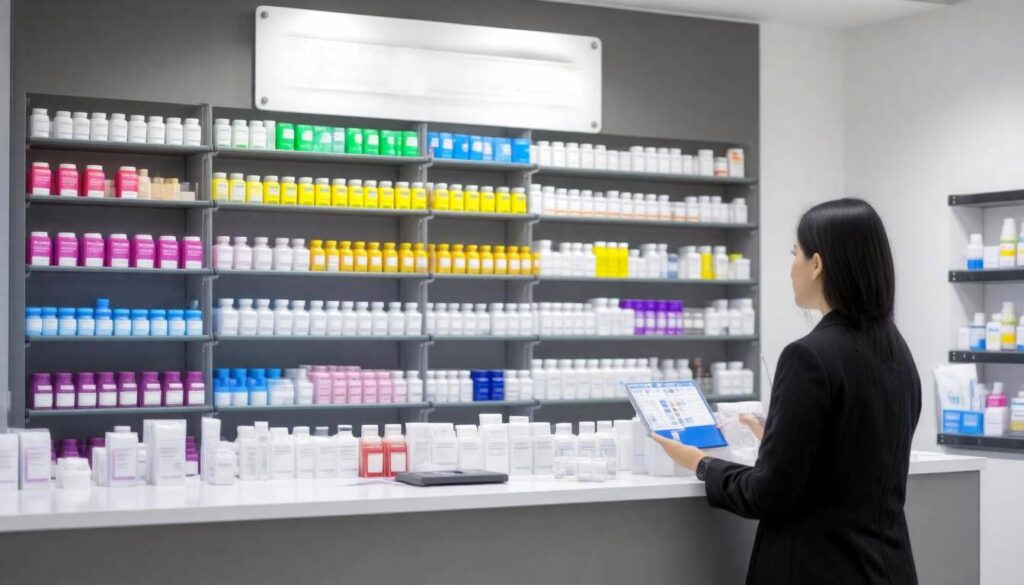Specialty pharmacies might sound like just another type of drug store, but they play a vital role in our healthcare system—especially for people with serious health conditions. Imagine a place where complicated treatments meet tailored support; that’s what specialty pharmacies offer. They don’t just hand out prescriptions; they work closely with patients, helping them navigate expensive medications and making sure they stick to their treatment plans. In this article, we’ll dive into how these unique health hubs operate, discover the various ways they earn money, and shed light on the financial challenges they face while providing essential services to those who need them most.
Specialty pharmacies primarily generate revenue by acquiring high-cost medications at discounted rates under programs like the 340B program, then selling them at higher market prices. This profit is further enhanced through various contract pharmacy fee structures and reimbursement mechanisms that allow them to capitalize on the significant markup potential of specialty drugs.

Inside a Specialty Pharmacy
Specialty pharmacies serve as crucial hubs for patients navigating complex health issues. Unlike traditional pharmacies, they are designed specifically for high-cost medications.
This creates an environment tailored to patient care, where the focus is not just on dispensing drugs but also ensuring comprehensive support throughout the treatment process.
A Behind-the-Scenes Look
Upon stepping into a specialty pharmacy, you’ll quickly observe their commitment to patient-centered services. Dedicated pharmacists and healthcare professionals work closely with each patient to provide specialized education about their medications, helping to demystify complex regimens.
They also offer adherence counseling to ensure patients stay on track with their treatment plans—a critical component since these high-cost therapies can be overwhelming.
It’s not just about handing over prescriptions; it involves careful monitoring of each patient’s journey through therapy. The goal is to foster an environment that empowers patients while minimizing any potential side effects or complications related to their medications.
By being proactive in care coordination, specialty pharmacies become integral partners in the patient’s overall health management.
Advanced Tracking and Support Systems
Technology plays a significant role within specialty pharmacies. They utilize advanced tracking systems designed to monitor not only medication adherence but also patient outcomes and even inventory levels.
This level of detail is crucial, especially when dealing with high-cost treatment options that often require precision and personalized administration methods.
Proprietary software systems integrate seamlessly with Electronic Health Records (EHRs) ensuring all relevant patient information is instantly accessible for pharmacists and healthcare providers alike. This integration allows for real-time monitoring of treatment effectiveness and timely interventions as needed.
As a result, specialty pharmacies help facilitate a cohesive treatment experience wherein all teams involved—from doctors to pharmacists—collaborate effectively, ensuring every angle of patient care is addressed.
Overall, it’s clear that specialty pharmacies do much more than simply dispense medication; they are vital partners in managing complex health conditions through dedicated support services and cutting-edge technology. Their unique approach enhances treatment efficacy and ultimately leads to better health outcomes for patients navigating challenging medical landscapes.
Income Sources for Specialty Pharmacies
One major source of revenue comes from service fees associated with patient management activities. These fees can originate from a variety of support services that specialty pharmacies provide, including comprehensive patient education and ongoing monitoring. By focusing on the needs of patients who often require complex medication regimens—such as those dealing with chronic illnesses like cancer or HIV—these pharmacies can justify their fees, which might seem high compared to traditional pharmacies.
Here are some key activities that contribute to generating service fees:
- Patient Support Programs: Helping patients navigate their treatment options and manage side effects.
- Medication Adherence Initiatives: Following up with patients to ensure they are taking their medications as prescribed.
- Care Coordination: Collaborating with healthcare providers to streamline the process and enhance patient care.
Patient Payments
Another notable income stream comes from direct patient payments, which account for approximately 20% of total revenue. These payments often arise from co-payments or co-insurance that insured patients must pay out of pocket for their medication. While the price may seem daunting, this model enables specialty pharmacies to offer high-cost medications without steep losses and serve a significant population who may otherwise struggle to access these treatments.
However, there’s more than just service fees and patient payments at play when it comes to how these entities thrive financially.
Pharmaceutical Partnerships
Specialty pharmacies also engage in partnerships with pharmaceutical manufacturers, accounting for around 15% of their revenue. Through these collaborations, pharmacies can negotiate favorable pricing agreements or rebates, allowing them to sell medications at competitive rates while still turning a profit. In many cases, these partnerships ensure that manufacturers have a dedicated channel for distributing their high-cost drugs, benefiting both parties involved.
This cooperative relationship ultimately helps lower costs for pharmacies while simultaneously enhancing medication access for patients who need it most.
The combination of insurance reimbursements, service fees, direct patient payments, and pharmaceutical partnerships yields a vibrant ecosystem for specialty pharmacies. Yet another layer magnifies their profitability: ancillary services.
Ancillary Services
Finally, we cannot overlook the role of ancillary services in enhancing overall revenue streams. Though they may only contribute a small amount of total income, these services include everything from diagnostic testing to lab work provided directly through the pharmacy. By offering these added conveniences in one location, specialty pharmacies not only meet patient needs but also further solidify their position in the healthcare landscape as comprehensive providers.
Diving deeper into this financial framework reveals even more intricate mechanisms that play a critical role in sustaining operations and profitability, particularly when it comes to navigating reimbursement processes with various insurers.
Insurance Reimbursement Explained

Insurance reimbursement serves as the lifeblood for specialty pharmacies, driving their financial sustainability. However, this revenue mechanism involves much more than just sending a bill to an insurer and waiting for payment. It begins with a multi-step process that requires meticulous attention to detail. Once a patient receives their medication from the pharmacy, the first action taken is to submit a claim to the insurance company. This initial step might sound simple, but it’s where the complexity starts.
The Process Explained
After a claim is submitted, the insurance company doesn’t just release funds outright; instead, they analyze the claim based on several factors. Each insurer has predefined reimbursement rates based on negotiations between the pharmacy and the insurer, as well as compliance with policy terms and conditions.
If everything aligns correctly—dispensing dates, dosage details, and patient eligibility—the insurer then authorizes a payment, which can take time depending on their internal processing queue.
One important thing to note: delays can occur at any stage of this process, impacting cash flow for specialty pharmacies.
Yet, even once a claim is approved, various challenges can hinder timely payments and affect overall profitability.
Challenges in Reimbursement
Specialty pharmacies face myriad challenges that often complicate the reimbursement landscape. One significant hurdle is obtaining prior authorizations. This involves verifying that the prescribed medication is indeed covered by the patient’s insurance plan before any dispensing occurs. While necessary for ensuring patients receive appropriate medications, these prior authorization processes can drag on for days or even weeks, introducing uncertainty into cash flow management.
Additionally, specialty pharmacies must navigate Direct and Indirect Remuneration (DIR) fees imposed by insurers and Pharmacy Benefit Managers (PBMs). These fees are assessed post-transaction and essentially reduce what pharmacies ultimately receive in reimbursement after dispensing medications. It’s as if you’re trying to fill a balloon with air only to find out someone is poking holes in it all along.
As payment models evolve, so too do these challenges, making it essential for specialty pharmacies to invest significantly in administrative staff who can adeptly handle claims management.
To conquer these hurdles effectively, successful specialty pharmacies develop robust systems to manage claims efficiently while investing in training staff to stay current with insurance regulations and changes in drug coverage policies.
This focus on adaptability not only aids in navigating complexities but also enhances customer satisfaction through streamlined service delivery. The following section will explore how patients interact with different payment structures in their healthcare journey.
Patient Payment Models
Out-of-pocket expenses associated with specialty medications are not just a side note; they are often an overwhelming reality for many patients and their families. Given the steep costs of these treatments, specialty pharmacies have devised several payment models to ease this burden and ensure that patients can access vital medications without incurring crippling debt. This proactive approach is essential for maintaining not only individual health but also the overall integrity of healthcare systems.
Co-pays and Co-insurance
One common model that patients encounter is the concept of co-pays and co-insurance. Many insurance plans stipulate that patients pay a certain amount upfront—they might ask for a co-pay or co-insurance related to these costly prescriptions. For instance, if a medication’s cost is $5,000 and the patient’s responsibility is set at 20%, that brings the out-of-pocket expense to a staggering $1,000. The numbers can be daunting and often leave patients anxious about how they will afford their necessary treatments.
However, many individuals are unaware that some insurance plans have provisions specifically tailored for these high-cost drugs, which can significantly alter their financial responsibilities.
Patient Assistance Programs
Recognizing this persistent challenge, many specialty pharmacies have established partnerships with pharmaceutical manufacturers to offer patient assistance programs designed as lifelines for those who qualify. These programs can dramatically reduce or even entirely eliminate out-of-pocket expenses for eligible patients, making critical medications more accessible.
To qualify, patients usually need to provide proof of their financial situation—like income level or insurance status—indicating they would truly benefit from this aid. Once verified, assistance might come in various forms: lower copayments, full coverage of prescription costs, or other financial resources designed to minimize strain. It’s essential for patients to inquire about these programs because what seems like an insurmountable expense could very well be alleviated through available assistance.
Cost Structures and Profit Margins
Specialty pharmacies operate on a distinct financial plane compared to traditional retail counterparts. One of the defining attributes of specialty pharmacies is their significantly elevated cost of goods sold (COGS). This is primarily due to the high price tags accompanying specialty medications, many of which are life-saving treatments for serious conditions like cancer or HIV.
For instance, a treatment regimen for certain cancers can easily exceed $10,000 per dose. This high baseline cost means that specialty pharmacies must navigate complex pricing dynamics as they work to remain profitable.
Interestingly, despite these elevated costs, specialty pharmacies can maintain robust profit margins. When analyzing the numbers, it’s clear that even a modest margin of 5-10% on these high-cost drugs translates into substantial revenue. Consider this: on a drug priced at $10,000, a 5% profit margin translates to a nifty $500. Thus, relatively small percentage gains can lead to considerable profits—not just for one transaction but potentially across thousands of prescriptions filled in a calendar year.
As you process this information, remember that fluctuations in pharmacy reimbursements can further affect profitability. Variances from third-party payers may mean earnings aren’t always consistent, often hinging on how fees are structured and negotiated.
Impact of Fee Structures
The operational realities dictate that specialty pharmacies need to be strategic about their fee structures when engaging with insurance companies and Pharmacy Benefit Managers (PBMs). These entities often dictate terms that can complicate cash flow management. Among the prominent arrangements are flat fees or percentage-based fees structured around reimbursements.
Understanding these fee dynamics can help specialty pharmacies optimize their revenue and ensure they maintain healthy profit margins despite the intricacies surrounding their cost structures.
Of note is the potential disparity between acquisition costs and reimbursement rates. While specialty pharmacies might secure medications at significantly reduced prices through programs such as the 340B program, they often charge patients—especially those who are uninsured—much higher amounts. This creates an opportunity for profit but also highlights ethical considerations regarding access and affordability of these vital medications.
Large-scale financial success relies not only on managing high costs and complex reimbursement landscapes but also on optimizing pricing strategies tailored specifically for their market niche.
Understanding the unique positioning of these pharmacies in the healthcare ecosystem lays the groundwork to explore their collaborations and partnerships with pharmaceutical firms, which further shape their business model.
Pharmaceutical Company Partnerships

These collaborations are essential for specialty pharmacies. They not only enhance the services offered but also improve medication access for patients who need them most. By forging strong ties with pharmaceutical manufacturers, specialty pharmacies create a unique position in the market, allowing them to deliver specialized medications, such as those required for chronic conditions like cancer and HIV. These partnerships often translate into better patient outcomes by securing exclusive access to innovative therapies that might otherwise be out of reach for many patients.
Benefits of Partnerships
One of the primary advantages of these partnerships is exclusive distribution rights. Such agreements allow specialty pharmacies to carry drugs that may not be available through other channels. This exclusivity helps pharmacies differentiate themselves from competitors and solidifies their role as indispensable players in the healthcare continuum. For instance, when a new breakthrough drug is approved for a specific condition, the pharmacy that holds the exclusive right can provide it without the worry of surrounding competition.
Exclusive Distribution Rights
Having exclusive distribution agreements establishes a competitive edge for specialty pharmacies. It allows them to cater to unique patient needs while positioning them strategically within their local healthcare markets. Patients with rare or complex conditions often require specific medications that aren’t stocked by typical brick-and-mortar pharmacies; these exclusive partnerships ensure that those essential drugs are readily available.
Furthermore, such agreements can lead to innovative treatment programs, which receive research funding from pharmaceutical partners interested in improving application methodologies or patient response rates. This financial support enables specialty pharmacies to develop educational programs and adherence strategies aimed at ensuring patients effectively utilize their prescribed therapies.
As we investigate further into these intricate relationships, we can uncover how they reflect larger market dynamics and identify potential challenges moving forward. The implications of this model pave the way for understanding barriers while embracing opportunities for continued growth.
Market Barriers and Growth Opportunities
The landscape of specialty pharmacies resembles a double-edged sword; on one side, they face key challenges that can significantly delay or even halt progress, while on the other, a plethora of chances for expansion beckon.
Key Challenges
Among the primary obstacles are regulatory compliance hurdles that often feel insurmountable. Specialty pharmacies must navigate a maze of regulations to obtain necessary accreditations, which can be costly and time-consuming. For example, the fees associated with these certifications can easily deter smaller players from entering the market altogether, favoring larger companies with deeper pockets.
Additionally, high start-up costs create another layer of complexity. These include not just financial investment in infrastructure but also recruitment of specialized staff capable of managing the unique needs of patients requiring specialty drugs.
Growth Opportunities
Despite these daunting challenges, an array of growth opportunities exists within this niche market. An aging population coupled with a rise in chronic diseases—such as diabetes and heart disease—signals an increasing demand for specialized medications. This growing need creates a fertile ground for specialty pharmacies to flourish.
Hospitals and physicians are more frequently recognizing the role of specialty pharmacies in patient care management, resulting in increasing referrals and collaborations that enhance visibility and credibility for these businesses.
Regulatory Pathways
Navigating regulatory pathways successfully is vital for unlocking new revenue streams. Specialty pharmacies equipped with knowledgeable compliance teams can establish themselves as trustworthy entities in the healthcare ecosystem. Investment in regulatory expertise not only streamlines operations but also enhances patient safety—a critical concern in today’s pharmaceutical landscape.
Thus, while the barriers may appear intimidating, proactive businesses willing to adapt their strategies and embrace compliance stand to benefit immensely from the burgeoning demand within this sector. By fostering partnerships and prioritizing skilled staff development, specialty pharmacies position themselves not just for survival but for thriving in an increasingly competitive market.
In summary, understanding the dynamics of both challenges and growth opportunities is essential for success in the specialty pharmacy landscape. By focusing on compliance, collaboration, and strategic investment, these businesses can maximize their potential.
Related Resources
- Gel packs for medical center pharmacies
- Pharmaceutical Companies and Test Labs
- Pharmaceutical Medications Packaging Products

Contact Us Today to Learn Order Pharmaceutical Packaging Products
